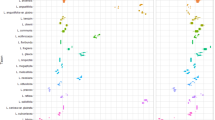Abstract
Polymorphisms for six enzyme systems (GPI, IDH, PDG, PGM, SKD, and TPI) were analysed in the top onion,Allium ×proliferum. Five multilocus isozyme genotypes were found. The banding patterns of top onions were compared with those ofA. ×wakegi, A. cepa, A. fistulosum, A. altaicum, and artificial hybrids between these three species. One top onion type and one artificial hybrid had identical banding patterns. Shallots andA. altaicum, the wild progenitor ofA. fistulosum, cannot be distinguished from the common onion andA. fistulosum, respectively; these species are also potential contributors to the top onion's gene pool.
Similar content being viewed by others
References
Albini, S. M., Jones, G.H., 1990: Synaptonemal complex spreading inAllium cepa andAllium fistulosum. III. The F1 hybrid. — Genome33: 854–866.
Doležel, J., Novák, F. J., Lužny, J., 1980: Embryo development and in vitro culture ofAllium cepa and its interspecific hybrids. — Z. Pflanzenzücht.85: 177–184.
Hanelt, P., 1990: Taxonomy, evolution, and history. — InRabinowitch, H. D., Brewster, J. L., (Eds): Onions and allied crops,1, pp. 1–26. — Boca Raton, Florida: CRC Press.
Havey, M. J., 1991: Molecular characterization of the interspecific origin of viviparous onion. — J. Heredity82: 501–503.
Helm, J., 1956: Die zu Würz- und Speisezwecken kultivierten Arten der GattungAllium L. — Kulturpflanze4: 130–180.
Hizume, M., 1994: Allodiploid nature ofAllium wakegi Araki revealed by genomic in situ hybridization and localization of 5S and 18S rDNAs. — Japan. J. Genet.69: 407–415.
Inden, H., Asahira, T., 1990: Japanese bunching onion (Allium fistulosum L.). — InRabinowitch, H. D., Brewster, J. L., (Eds): Onions and allied crops,3, pp. 159–178. — Boca Raton, Florida: CRC Press.
Jones, H. A., Mann, L. K., 1963: Onions and their allies. Botany, cultivation, and utilization. — London: Hill.
Kazakova, A. A., 1978: Luk tatarka (Allium fistulosum L.). — InBrezhnev, D. D., (Ed.): Kul'turnaja flora SSSR,10, pp. 54–61 (in Russian). — Leningrad: Koloz.
Ker-Gawler, G., 1812:Allium cepa (The bulb-bearing variety). — Bot. Mag.36: no. 1469.
Li, H.-L., 1970: The origin of cultivated plants in Southeast Asia. — Econ. Bot.24: 3–19.
Maass, H. I., Klaas, M., 1995: Infraspecific differentiation of garlic (Allium sativum L.) by isozyme and RAPD markers. — Theor. Appl. Genet.91: 89–97.
McCollum, G. D., 1974: Hybrid origin of the top onion,Allium cepa var.viviparum. — Z. Pflanzenzücht.71: 222–232.
Moench, C., 1794: Methodus plantas horti botanici et agri marburgensis. — Marburg.
Phillips, R., Rix, M., 1995: Vegetables. — London: Macmillan.
Tashiro, Y., Oyama, T., Iwamoto, Y., Noda, R., Miyazaki, S., 1995: Identification of maternal and paternal plants ofAllium wakegi Araki by RFLP analysis of chloroplast DNA. — J. Jap. Soc. Hort. Sci.63: 819–824.
Author information
Authors and Affiliations
Rights and permissions
About this article
Cite this article
Maass, H.I. Genetic diversity in the top onion,Allium ×proliferum (Alliaceae), analysed by isozymes. Pl Syst Evol 208, 35–44 (1997). https://doi.org/10.1007/BF00986081
Received:
Revised:
Accepted:
Issue Date:
DOI: https://doi.org/10.1007/BF00986081




